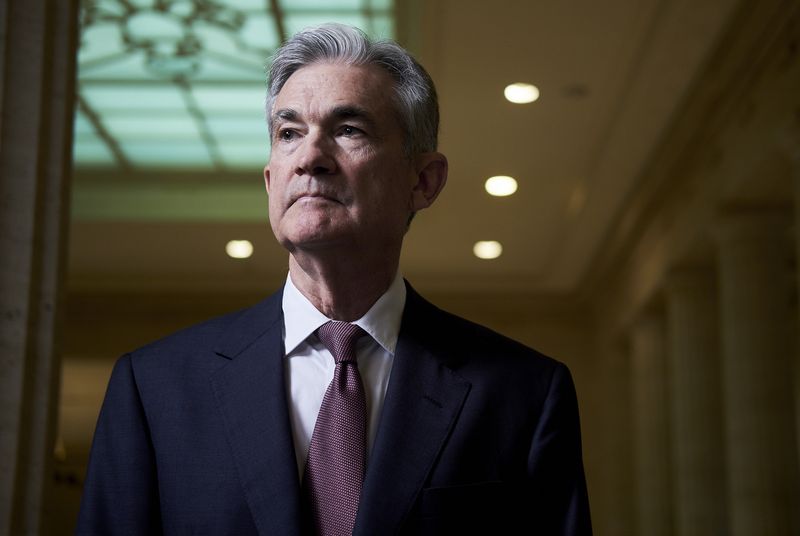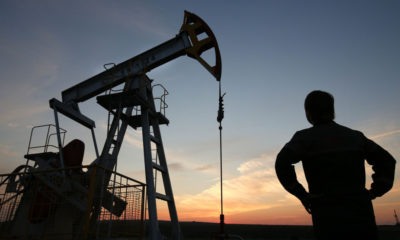Markets
Jerome and the Three Bears
Published
3 years agoon

By Jeffrey Halley, Senior Market Analyst, Asia Pacific, OANDA
Federal Reserve Chairman Jerome Powell, testifying at his confirmation hearing on the Hill, soothed markets overnight in a performance worthy of Goldilocks and the Three Bears. Mr Powell noted that the Fed could hike rates to rein in inflation, intended to start the balance sheet run-off sooner rather than later, but also said inflationary pressures would peak mid-year. What he didn’t say was also important. He didn’t back four rate hikes in 2022, nor a March start to hikes, nor did he give any details on when the Fed balance sheet run-off would start.
It was a masterful performance really, leaving the bowls neither too full nor too shallow; but just right from the financial market’s perspective. Ignoring recent comments from hawkish FOMC members while reinforcing that the Fed has likely accomplished its employment objective and was well aware of the inflation one. Certainly, if Mr Powell believes inflation will peak in H2 2022, there seems no need for a panicked start to hikes in March, let alone four of them. If anything, that the Fed has shown over the past two years, it is an abundance of caution and patience.
That was enough to unleash the buy-the-dip gnomes, who had been straining at the leash these past few sessions. Equities rallied, oil rallied, US yields fell, the US Dollar fell, and even gold rallied. As goldilocks as it gets. Even if the Fed hikes to 1.0%-1.25% this year, real US yields will still be very negative. Hardly corporate finance Armageddon. The music can still play in equity markets in 2022, it’s just that we’ve likely seen the best of the technology gains, and markets will see a lot more two-way price action to keep them honest. Nor am I ruling out a 10-15% drop in US markets and other Caligula’s of Valuations, they would still be comfortably in a longer-term bullish uptrend.
Today has seen a few data releases from Asian heavyweights China, South Korea, and Japan. All of which sounded cautious notes for varying reasons. China’s YoY Inflation Dec came in at 1.50% vs 1.80% exp. South Korean Unemployment crept higher unexpectedly to 3.80%. In both circumstances, the blame can be laid on omicron restrictions crimping domestic economic activity. Cases are quietly climbing in Mainland China and Hong Kong, along with widening restrictions, and with Covid-zero policies in place, omicron presents a serious growth risk to China if it fully jumps the fence.
Conversely, Japan’s Reuter’s Tankan Index fell to 17.0 for January from 22.0 in December as Japanese businesses grappled with rising prices. That’s correct, your eyes are not deceiving you. Japanese businesses are grappling with rising prices and may have to raise prices. That will be a 30-year shock to the system but don’t expect any action from the Bank of Japan. The pandemic may have finally done the job that the Ministry of Finance and bank of Japan spent decades failing at.
India releases inflation later this evening and there are definite upside risks to the expected 5.80% print. Throw in rising omicron cases into a low vaccination population, and new social restrictions in cities such as New Delhi, and the ingredients are there for a stagflationary surprise. A high inflation print tonight will do the INR and Sensex no favours tomorrow.
We also get German Wholesales Prices and Eurozone Industrial Production this afternoon, but the main event will be the US Headline and Core Inflation YoY for December, expected at 7.0% and 5.40% respectively. Although Mr Powell managed to goldilocks the market overnight, keeping his three bears at bay, if US inflation tops 7.0% this evening, all his good work could be undone.
Asian equities jump on Wall Street rally.
The soothing words of Jerome Powell overnight unleashed anxiously waiting, but side-lined buyers, resulting in a strong overnight recovery by Wall Street. The S&P 500 rallied 0.92%, the Nasdaq leapt higher by 1.41%, and the Dow Jones rose 0.52%. In Asia, futures on all three have held steady.
Asian markets have coat tailed the New York rally and moved higher today. Notably, those that have struggled as the Nasdaq fell over the past few seasons. The Nikkei 225 has jumped 1.75% higher in response, with the South Korean Kospi rallying 1.15%, and Hong Kong also leaping 1.75% higher.
Mainland China’s Shanghai Composite has drifted 0.15% higher, with the more growth-centric CSI 300 climbing by 0.45%. Singapore and Taipei have drifted 0.15% higher, while Jakarta has gained 0.45%, and Kuala Lumpa and Manilla are unchanged. Australia’s ASX 200 and All Ordinaries have added 0.45% today.
The broader rally has favoured more value-centric markets with a heavier correlation to the Nasdaq today. As such, I am not expecting fireworks from Europe when it opens, having enjoyed a good season with the US overnight. The US inflation data will be the next hurdle for the equity rally continuance. Above 7.0% likely brings the inflation trade back, limiting gains, while a sub 6.50% headline should keep the party going as Fed hiking timetables get reset back to mid-year.
Risk sentiment recovery pushes US Dollar lower.
The Powell-inspired risk sentiment rally overnight saw US yields edge lower and weighed heavily on the US Dollar, which staged a broad retreat. The dollar index fell 0.36% to 95.60, just above support at 95.50. The US inflation data tonight will either confirm a period of US Dollar weakness or result in a nasty whipsaw price action. In the meantime, I wait patiently for a daily close above or below 95.50 or 96.50 to signal the US Dollar’s next directional move.
EUR/USD and GBP/USD gained around 0.40% to 1.1370 and 1.3640, where they remain unchanged in Asia. EUR/USD’ needs to close above 1.1400 to lessen the bearish outlook. However, GBP/USD has closed above 1.3600 and should now target 1.3800 in the days ahead, partying like some private drinks at 10 Downing Street. USD/JPY is steady at 115.25 but remains a bid on dips into 115.00 as long as US yields remain at these levels.
AUD/USD and NZD/USD are unmoved in Asia after edging higher to 0.7210 and 0.6790. Both continue to be bounced around on RORO (risk-on, risk-off) sentiment swings, but ultimately, are range-trading right now. The moves higher overnight weren’t overly convincing suggesting nerves ahead of US inflation data tonight. Key levels for AUD/USD are 0.7150 and 0.7300, and 0.6700 and 0.6850 for NZD/USD.
USD/CAD tumbled 0.85% to 1.2570 overnight and has activated a hand-and-shoulders formation after closing below the neckline at 1.2630. The reasons for the Canadian Dollar rally still elude me but I will respect the technical picture. That now suggest USD/CAD can fall to between 1.2300 and 1.2360 in the days ahead.
USD/Asia softened overnight, with regional currencies strengthening slightly as Jerome Powell took the wind out of the Fed tightening trade. USD/KRW has fallen to 1190.00, USD/PHP to 51.00, while USD/MYR has eased to 4.1790, and USD/THB to 33.369. USD/CNY and USD/CNH remain just below the key pivot level at 6.3800, trading at 6.3650 and 6.3700 respectively today. which is becoming a key pivot point now. Activity is muted in Asia with the region clearly waiting for US inflation data tonight before deciding its next moves.
Oil prices leap higher after Powell testimony.
Oil prices rocketed higher overnight as the Powell testimony removed the threat of early rate hikes, for now, allowing the fundamentals of constrained OEPC+ production, and an omi-gone variant recovery, to reassert themselves with a vengeance. Brent crude rocketed 3.25% higher to $83.60 a barrel, while WTI leapt 3.65% higher to $81.25 a barrel. Both contracts have firmed slightly in Asia to $83.80 and $81.45 a barrel respectively.
This sets the scene for more gains in the week ahead, having traded sideways the past few sessions as equity markets have corrected lower. It seems that even the threat of faster tightening by the Fed over the past few days couldn’t undermine oil prices, and if US inflation is lower than 6.50% tonight, after the Powell comments overnight, then oil prices should continue rising. Assuming China doesn’t suffer a sharp slowdown, that omicron actually becomes omi-gone, and with OPEC+’s ability to raise production clearly limited, I see no reason why Brent crude cannot move towards $100.00 in Q1, possibly sooner. Having said that, I acknowledge there are plenty of variable outcomes in the previous sentence, the biggest threat being omicron in China, India, and Indonesia.
In the nearer term, Brent crude has support at $83.00 and $81.00 a barrel, with resistance at $86.00 a barrel. WTI has support at $80.50 and $78.50 a barrel, with resistance at $82.00 and 85.00 a barrel. One note of caution is that both Relative Strength Indexes (RSIs) are moving towards overbought. That could limit oil’s gains for the rest of the week and could signal a short-term correction but won’t change the underlying bullish outlook.
Gold rallies in Asia.
Gold saw the fast-money buyers return overnight as the Fed tightening trade was stopped in its tracks by Jerome Powell’s testimony. That pushed gold 1.10% higher to $1821.50 an ounce. As ever, I believe the rally should be taken with a huge grain of salt, as past price action suggests gold will fall just as quickly at the first sign of stalling momentum. A higher US inflation print could create that situation tonight.
Gold has edged lower to $1819.00 an ounce in Asia and has resistance just above at $1823.50, and $1830.00 an ounce. Support lies at $1800.00, followed by $1785.00 and $1780.00 an ounce.
You may like
-


Spike in Russia-Ukraine War Triggers Rise in Oil Prices
-


Crude Oil Prices Dip on Russia-Ukraine War Escalation, Rise in US Crude Stocks
-


Oil Prices Dip as Norway’s Johan Sverdrup Resumes Production Amid Global Developments
-


Norway Power Supply, Russia-Ukraine War Add $2 to Oil Prices
-


Crude Oil Faces Pressure: Demand Concerns Outweigh Geopolitical Developments
-


Weaker Chinese Demand, Fed Rate Cuts Uncertainty Weaken Oil Prices



